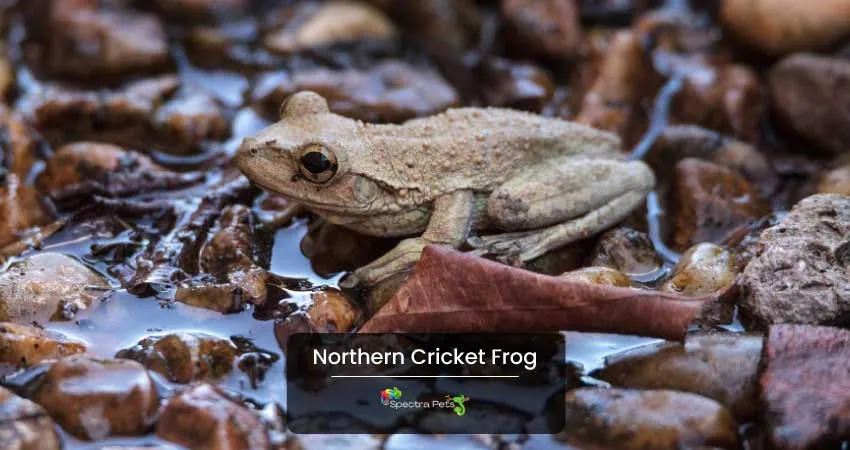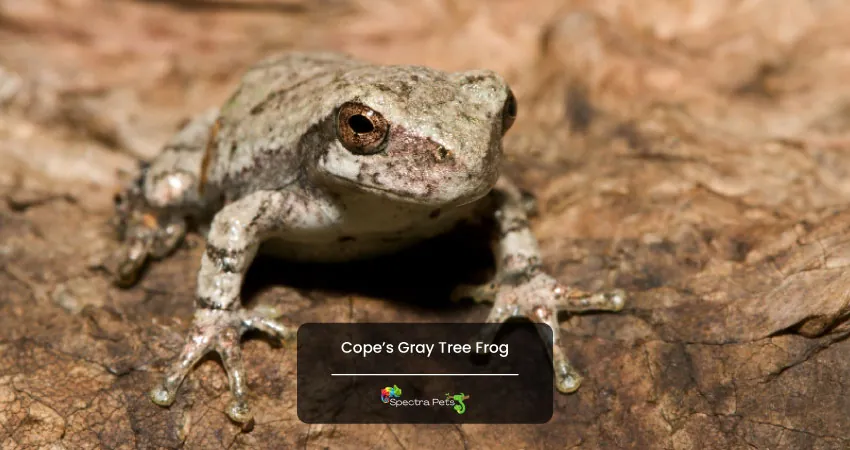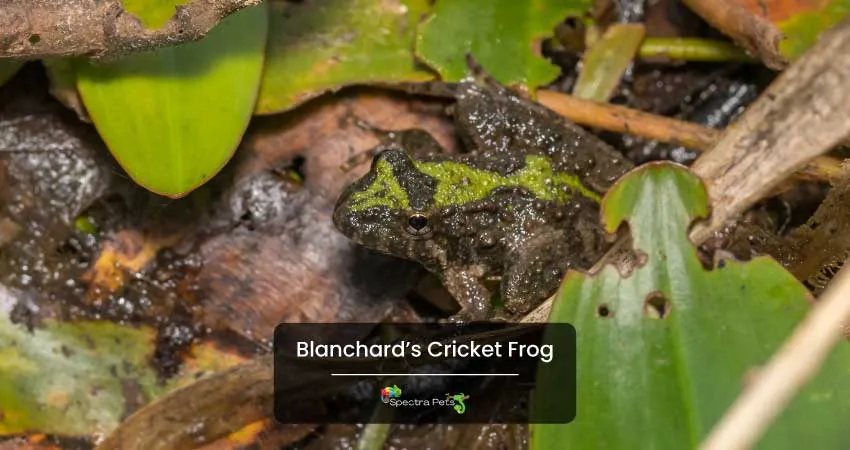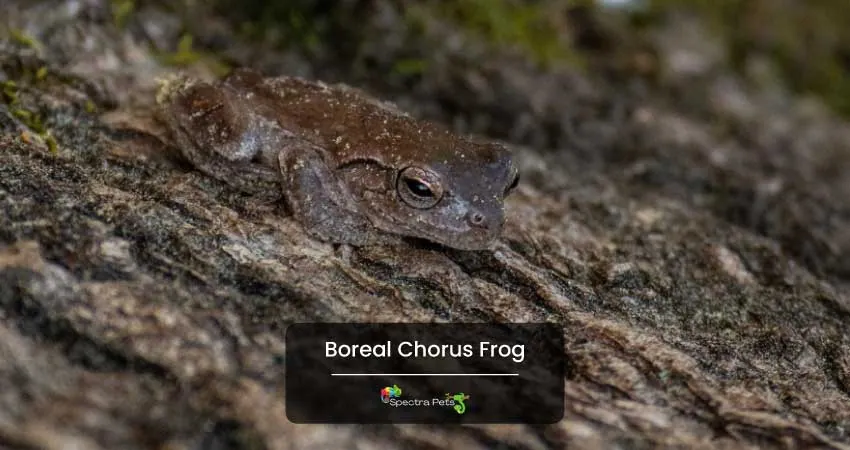As long as you have an interest in the tree frog of Nebraska there’s a lot to learn from this short article. Tree frogs are such key players in Nebraska’s ecosystem that all citizens should be grateful to these tiny critters.
In Nebraska, you will find only 4 tree frogs these are Northern cricket frog, Cope’s Gray tree frog, the Boreal chorus frog, and Blanchard’s cricket frog.
Below I will talk about the natural habitat, breeding season, sexual maturity, diet, predator, breeding site, body size, dorsal color, etc of the local tree frogs. So, let’s have a deep-down look at the tree frogs without downloading anymore.
1. Northern cricket frog

This species of tree frog has a good population across many states of the USA that includes Nebraska, Texas, Alabama, Pennsylvania, South Dakota, etc. The native people of Nebraska have heard their calling which is similar to cricket’s sound.
In terms of natural habitat, they like to stay close to marshes, slow streams, shallow water zones, farm ponds, etc. Along with that, high vegetation area is their ultimate comfort zone.
Among the Hylidae family, this species is a mid-size one and grows around 1.5″ in length. Like other frogs, the males are smaller than the female. Thanks to their strong legs which help them to evade the predator. This lightweight critter can cross 3 feet distance with a single jump. Adding to that, they are first-class swimmer that gives the hunter a hard time.
Usually, the tree frog’s diet does not vary from one to another and this one also eats common food like mosquitos, beetles, termites, flies, and ants.
Moreover, their dorsal shades can be green, black, brown, or gray. And all these shades serve as camouflage in the natural habitat. Along with that, the dark spots on their back help them to become more unnoticeable in the wild.
By nature, these creatures are terrestrial and stay as low-key species on the ground. This wonderful amphibian brumates as soon as winter steps in and their typical shelter include pond cracks or under tree logs.
When it comes to lifespan, they enjoy 1-year life in the wild though the highest was found at 3+ years of age.
Furthermore, the breeding season remains from the end of May to August. Male frogs call out the females right after the breeding period starts. The female also makes a sound to communicate with the male frog and they prefer a male partner who emits short calls. This species gets their sexual maturity within 1 year.
2. Cope’s Gray Treefrog

The Cope’s Gray tree frog is a nocturnal amphibian native to the state of Nebraska. Humidity attracts them so much that they choose the woodland area as their habitat.
Plus, they can have different skin shades, such as pearl gray, gray-green, etc. Their belly color is white. Their skin color-changing ability gives them immense support in dodging the predators in their natural habitat.
Despite being excellent climbers, these creatures stay on the ground. When the temperature goes down, their skin turns darker shades & becomes lighter when temperature goes high.
Speaking of their lifespan, they get an average life of 2.5 years, however, the highest was found around 7 years old.
Moreover, they play a significant role in the ecosystem of Nebraska. Because they eat up a big chunk of insects around the years which includes beetles, mites, ants, moths, spiders, grasshoppers, tree crickets, etc.
In addition to that, these tiny amphibians hit their sexual maturity at 1-2 years old. For breeding sites, their favorite places include small water bodies like ponds or puddles. The breeding season remains from March- October.
Also, the male frog attracts the female with their mating tune. Within a few days of a perfect mating session, the female lays eggs on water. Close to 3 months from the mating time, the eggs become froglets.
Regarding their endangered level, they are considered the least concerned frog due to their higher population across many parts of the USA.
Among all the tree frogs, the Cope’s Gray tree frog is one of the largest with a size of 1.25-2.5″ in length.
3. Blanchard’s Cricket Frog

This mid-size tree frog is found in Nebraska, Kansas, Ohio, Texas & some other southeastern areas of the USA.
For living, their top-notch choice are marshes, lakes, rivers, mud flats, fens, low prairies, etc. This warty skin amphibian has a triangular mark on its head. And the male has a yellow color vocal sac that is absent in the female’s body.
Speaking of the breeding season, it starts in June & ends in July. In this short time, the male frog heavily calls out the female & engages in frequent mating. They like slow-moving water areas and small water bodies for their breeding sites.
During the breeding season, the Blanchard’s cricket frog can be heard at any time in their habitat. In terms of size, they grow 0.6-1.5″ in size and females are bigger than their male partners.
As soon as the summer appears, they become active both day & night. The overall population of this species is quite low compared to other tree frogs, so they are a special concern for amphibians.
In terms of skin color, the dorsal shades can be olive green, brown, greenish tan, or gray. Luckily these skin colors themselves work as camouflage in their wild habitat.
Sadly around 5% of their population can survive the harsh winter so the population always remains low. When it comes to their diet, they eat up any insects that fit in their mouth.
Moreover, these intelligent frogs know how to evade their predator swiftly. Every time they sense any hunter is nearby they will start jumping, reaching out to the closest water body.
4. Boreal chorus frog

The boreal chorus frog is one of the few tree frogs of Nebraska and it’s found in gray, green, olive, brown, tan, or red color shades. And their backside has red, brown, or gray color marks which give them a natural advantage of camouflage in the wild.
In terms of distribution, they are heavily distributed in a wider range of the USA including Nebraska, Arizona, Wisconsin, New Mexico, Minnesota, etc. Their body length can be around 0.75-1.5″.
Plus, this tiny critter chooses places like the woodland pond, grassland, and shrubland as their sweet home. The hibernation ability is a blessing for this species and they spend the harsh winter under thick vegetation, below rocks, and underground. In their natural habitat, they usually migrate around 250 meters.
In addition to that, this nocturnal amphibian breeding season starts at the end of March and continues until the first of June. At the beginning of the breeding period, males emit an attractive chorus to allure the female. Hearing the call, the females make their way to the breeding zone like flooded fields, swamps, small lakes, and temporary pools.
Though physically they are defenseless from the predator, their swimming & climbing skills make them a tough diet for the predators. Apart from the female being bigger than the male, another difference is that males have green or yellow shade throats while the female has cream-colored throat.
Regarding survival rate, the Boreal chorus frog lives 2 years on average in their natural habitat. However, some frogs can luckily live more than 3 years.
Furthermore, these magnificent animals provide a great service to the ecosystem of Nebraska by feeding on insects, spiders, ants, flies, earthworms, mites, etc.
Final wrap
Apart from knowing the natural beauty of the river view & agricultural marvel of Nebraska, the tree frog is undoubtedly an important thing to learn about.
I gave my peak effort to gift you with fresh & updated data to enrich your frog knowledge.
Hopefully, now you know a lot compared to others & will disseminate the knowledge to increase consciousness of the tree frogs in Nebraska.
Tree Frogs Found in the Nearby States of Nebraska:
